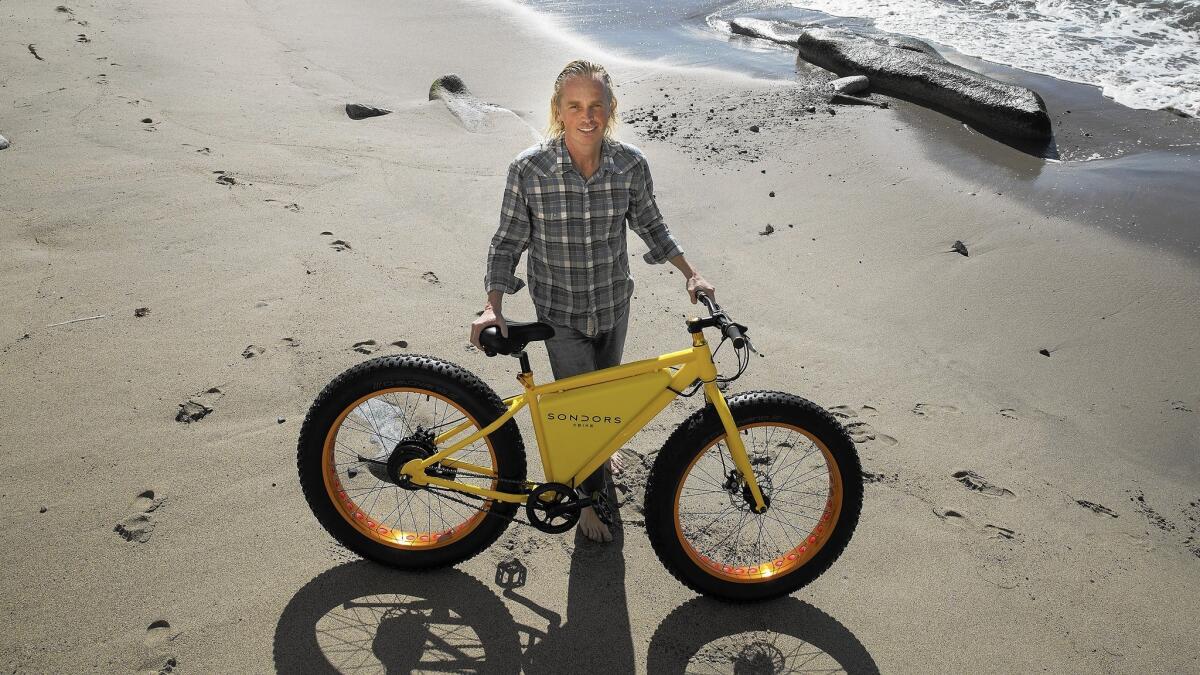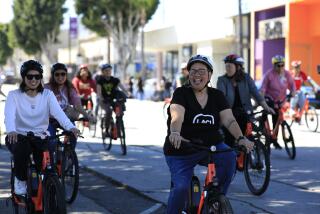Entrepreneur with Asperger’s peddling affordable electric bike

- Share via
Storm Sondors has a house in Malibu, a daily surfing routine and one of the hottest crowd-funding campaigns on the Internet.
------------
FOR THE RECORD:
E-bike entrepreneur: An article in the Feb. 28 Business section about entrepreneur Storm Sondors’ electric bicycle project and his living with Asperger’s misspelled his last name as Sonders. —
------------
The veteran entrepreneur has raised more than $3.6 million to build an affordable electric bicycle — after starting Feb. 1 with a goal of just $75,000.
But while entertaining visitors in his oceanfront living room one recent day, Sondors stared at the sea and fidgeted nervously.
“It’s the Asperger’s,” he said. “I’m just really not comfortable talking about myself.”
Sondors, with his surfer tan and beach boy blond ponytail, was 38 when a therapist first identified his condition three years ago. Growing up in Latvia, he said, his parents recognized something strange and special about him before he turned 3.
The eccentricity expressed itself in isolation and creativity. Sondors had difficulty going to school and playing with other children. Withdrawing, he became obsessed with woodworking, finished high school at 14 and went to art school as a sculptor.
By his early 20s, he was living in Chicago, building wooden models for toys — for Mattel, Fisher-Price and even McDonald’s Happy Meals. Soon he was running his own toy company, wholesaling radio-controlled cars, planes and helicopters to retail partners such as Wal-Mart, Kmart and Target.
The business success did not bring him happiness.
“I was miserable,” he said, running his long, delicate fingers through his hair. “I had a lot of anxiety being around people. I couldn’t make eye contact. I always felt like I just didn’t belong.”
A girlfriend finally insisted that he seek help, after a series of “tantrums” — what Sonders calls “a Level-10 response to Level-2 stimulus.”
It took the therapist less than 30 minutes to make the diagnosis.
Sondors had seen other therapists. He’d taken antidepressants. No one had ever mentioned Asperger’s syndrome.
But longtime friends were not entirely surprised at the assessment.
“He was always very driven — like a freight train,” said Todd Hannon, who has known and worked with Sondors for more than 20 years. “There was some odd behavior. He’d just suddenly walk out of a room. He’d blurt things out. People would say, ‘That guy is way too intense.’ ”
Asperger’s — which was declassified as its own diagnosis in 2013 and is now considered a mild form of autism — typically includes difficulties with communication and social interaction, often paired with intense or repetitive behaviors.
It commonly goes undiagnosed until adulthood, particularly in high-functioning or creative people — especially those Sonders’ age or older, said Dr. Susan Bookheimer, an autism expert who is director of the Intellectual and Developmental Disabilities Research Center at UCLA.
“People called them quirky or geeky or nerdy or awkward,” Bookheimer said. “And if someone is bright and verbal, they might go undiagnosed entirely.”
For Sondors, the diagnosis was a liberation.
“It was such a relief,” he said. “As a designer, it was important for me to understand the process. I started reading textbooks, and I was like, ‘Hey! You stole my life story!’ But I also realized it could change my life 100%.”
Therapy followed. Sondors practiced making eye contact and listening to questions, gradually learning how to be comfortable around other people. That made the electric bike campaign possible, he said.
“Otherwise,” he said, gesturing at the visitors in his home, “I could never do this. I couldn’t have people in my house asking questions. I like to be in the background. I don’t want anyone to know who I am.”
According to Jonathan Chaupin of Agency 2.0, Sonders’ fundraising campaign partner, the company has already sold 6,000 units of the Sondors E-Bike — all through the Internet, on the strength of a prototype and a series of public test rides — to become the third-most-successful campaign in Indiegogo’s five-year history.
Under the terms of the online crowd-funding campaign, participants could make a “Reserve Now, Pay Later” investment, or reserve a bike with a whole payment.
Most chose the latter, Sondors said. The first investors committed $499 for one of the brightly colored, fat-tire beach cruisers. Later investors were asked to pay $599 for a bike.
Either way, that’s far less than the cost of most electric bikes, which often sell for $2,500 or more, and less than half of the post-campaign price for the Sondors E-Bike, which will cost $1,299, plus a fee of about $200 for shipping.
The bike project began organically. Sondors, who had sold his toy company and was spending his days surfing and paddle-boarding, got interested in electric bikes after being sidelined with a knee injury. Last summer, he saw a friend’s fat-tire electric bike and loved it.
But it retailed at $4,000 — far more than Sondors was willing to pay for a bicycle, electric or otherwise.
So he designed a bike stripped of everything but the essentials — a frame, a single pedal gear, brakes and a battery — and made production deals with manufacturing contacts in Taiwan and China.
The resulting two-wheeler weighs 55 pounds, can go 20 mph and travel up to 50 miles between charges.
The bicycles are assembled in the Chinese manufacturing city of Shenzhen. The first units will be shipped in May, Sondors said, with deliveries to the people who contributed to the Indiegogo campaign continuing through the summer.
The e-bike has forced Sondors into the public eye, which he resisted.
“He didn’t want to be in the spotlight,” said Christopher Olenik, Agency 2.0 founder and chief executive. “But now he has to talk to people.”
Sondors agreed, calling the campaign “my coming-out situation.”
As part of the process, not long after the diagnosis, Sondors told his parents what the therapist had determined. His father was stunned. His mother wept.
“She felt if they would have known, it would have been easier for everyone,” Sondors said, “because it wasn’t an easy gig — to have a child like me.”
The diagnosis and the therapy didn’t eliminate Sondors’ autism. (“It’s a daily work,” he said. “You have to try. You have to stay present.”) He still prefers to surf alone and, though he owns a Dodge Durango, finds driving in traffic extremely stressful.
“For someone with Asperger’s,” he says, “there’s a lot going on.”
But freed from a lifetime of struggling to explain his quirkiness — to himself, and to friends and girlfriends — Sondors now wonders whether sharing his experience might help others in his situation.
Bookheimer believes that it will. Her most common new patients, she said, are self-referred adults who have heard or read something about Asperger’s or autism.
“ ‘I know there’s something wrong with me, but I don’t know what it is,’ ” she said they tell her. Almost all of them, she added, are somewhere on the autism spectrum.
“For people who have felt awkward and different all of their lives, to have a label, and to know they’re not alone, can be really life-changing,” Bookheimer said.
That knowledge allowed Sondors, for the first time, to interact comfortably with strangers. He now regularly engages with customers who want test drives of his e-bike.
“It was like I was born again,” he said. “I am no longer living in a jail of my own thoughts.”







